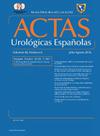原发性和进行性肌肉侵袭性膀胱癌的预后比较:根治性膀胱癌切除术后的长期预后分析
IF 1.2
4区 医学
Q3 UROLOGY & NEPHROLOGY
引用次数: 0
摘要
高达15%的肌肉浸润性膀胱癌(MIBC)是由非肌肉浸润性肿瘤的进展引起的。尽管采用了相似的治疗策略,但文献报道了这两组患者存活率的差异。本研究旨在确定复发率和生存率的差异可能影响个体化治疗方法。材料和方法:对2011年至2023年间膀胱切除术的MIBC患者进行前瞻性研究,收集人口统计学、诊断、治疗和复发数据(局部、尿路上皮或远处)。进行了比较和多变量分析。结果我们没有观察到原发性和进展性MIBC的复发率有显著差异。然而,进展组在2年、5年和10年的总生存率(OS)(100%、90%、55%)优于原发组(80%、55%、35%;P = 0.012),以及更好的癌症特异性生存率(CSS)(100%、100%、95%对85%、77%、65%;P = 0.033)。复发的独立危险因素包括pN + (OR: 3.72)和淋巴血管侵犯(LVI) (OR: 5.53)。低OS的预测因素包括年龄、淋巴结累及、LVI和任何程度的复发。对于CSS,预测因子包括淋巴结累及、LVI和任何程度的复发。结论在我们的研究中,进展性MIBC患者有更好的OS和CSS。在两组中,pN +和LVI是复发的独立危险因素。淋巴结累及、LVI和任何级别的复发是较差的OS和CSS的预测因子。本文章由计算机程序翻译,如有差异,请以英文原文为准。
Comparación del pronóstico entre carcinoma vesical musculoinvasivo primario y progresivo: análisis prospectivo de resultados a largo plazo tras cistectomía radical
Introduction
Up to 15% of muscle-invasive bladder cancers (MIBC) arise from the progression of a non-muscle-invasive neoplasm. Despite sharing similar treatment strategies, the literature reports differences in survival rates between these 2 groups. This study aims to identify differences in recurrence and survival that may influence individualized treatment approaches.
Material and methods
Prospective study of cystectomies performed for MIBC between 2011 and 2023, collecting demographic, diagnostic, treatment, and recurrence data (local, urothelial, or distant). A comparative and multivariate analysis was conducted.
Results
We did not observe significant differences in recurrence rates between primary and progressive MIBC. However, the group with progression showed better overall survival (OS) rates at 2, 5 and 10 years (100%, 90%, 55%) compared to the primary (80%, 55%, 35%; P = 0.012), as well as better cancer-specific survival (CSS) (100%, 100%, 95% vs. 85%, 77%, 65%; P = 0.033). Independent risk factors for recurrence include pN + (OR: 3.72) and lymphovascular invasion (LVI) (OR: 5.53). Predictors of lower OS include age, nodal involvement, LVI and relapse at any level. For CSS, predictors include nodal involvement, LVI and relapse at any level.
Conclusions
In our series, patients with progressive MIBC have better OS and CSS. For both groups, pN + and LVI are independent risk factors for recurrence. Nodal involvement, LVI and relapse at any level are predictors of poorer OS and CSS.
求助全文
通过发布文献求助,成功后即可免费获取论文全文。
去求助
来源期刊

Actas urologicas espanolas
UROLOGY & NEPHROLOGY-
CiteScore
1.90
自引率
0.00%
发文量
98
审稿时长
46 days
期刊介绍:
Actas Urológicas Españolas is an international journal dedicated to urological diseases and renal transplant. It has been the official publication of the Spanish Urology Association since 1974 and of the American Urology Confederation since 2008. Its articles cover all aspects related to urology.
Actas Urológicas Españolas, governed by the peer review system (double blinded), is published online in Spanish and English. Consequently, manuscripts may be sent in Spanish or English and bidirectional free cost translation will be provided.
 求助内容:
求助内容: 应助结果提醒方式:
应助结果提醒方式:


